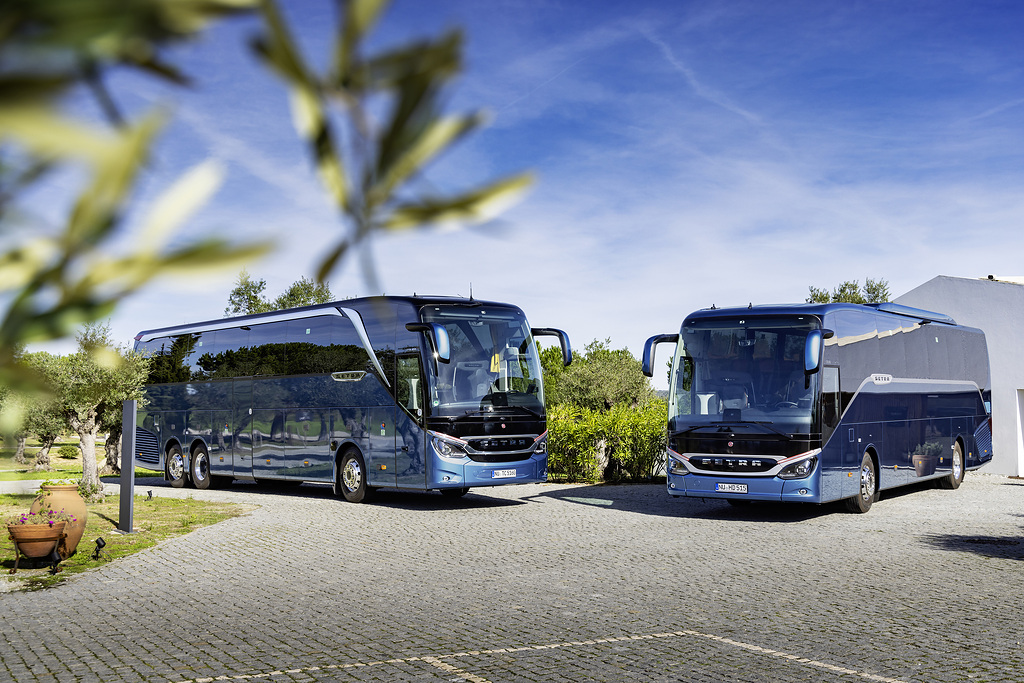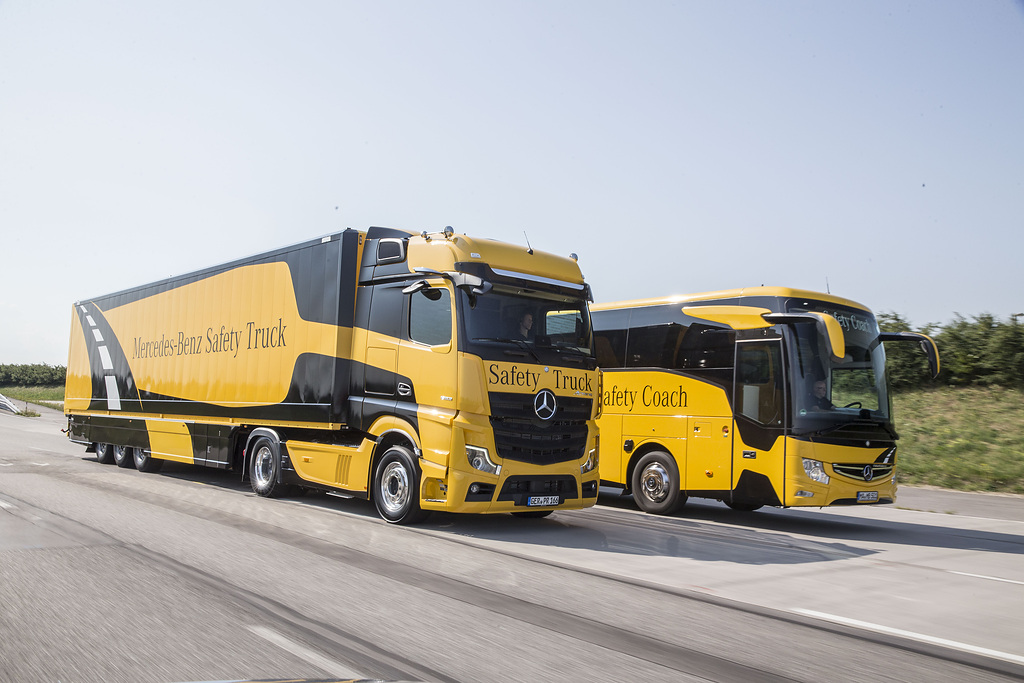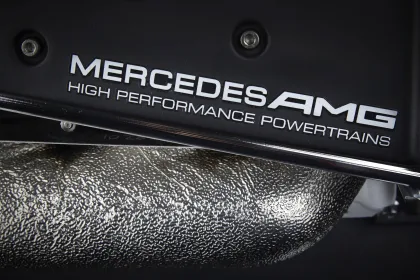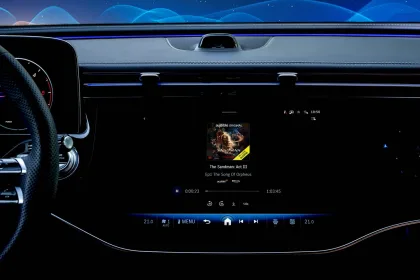- Numerous systems such as Active Brake Assist and Sideguard Assist were installed long before they were required by law.
- The developers at Daimler Truck have been working for years to provide drivers with ever better support in their work with safety assistance systems.
- Objective: To equip at least 75 percent of vehicles delivered in 2025 and at least 80 percent in 2030 with a safety system that exceeds the legal requirements in terms of performance and scope of application.
The vision of accident-free driving motivates Daimler Truck for all trucks and buses that are developed and produced in the group of companies and sold under the brands Mercedes-Benz, Freightliner, FUSO, Setra, Thomas Built Buses, Western Star, Bharat Benz and RIZON. The company has set itself the objective of equipping at least 75 percent of the vehicles delivered in its core markets in 2025 and at least 80 percent in 2030 with a safety system that surpasses legal requirements in terms of scope and performance. The great importance that Daimler Truck attaches to road safety is pointed out by the fact that the issue is firmly established in the long-term sustainable business strategy.
Within the brand portfolio of Daimler Truck, the Mercedes-Benz brand stands for technological pioneering achievements in the area of safety – the relevant safety systems are frequently used at Mercedes-Benz Trucks first and are then successively offered in other brands according to the global platform strategy depending on market requirements and customer requests. In 2022 alone, a variety of new safety and assistance systems were available in other markets, brands and models – such as Active Sideguard Assist in the Freightliner Cascadia and Active Drive Assist 2 in the Setra ComfortClass and TopClass coaches. The automatic emergency braking assistant, which was presented for the first time in 2006, also has a special success story. Active Brake Assist has been sold more than a million times to date in vehicles from Daimler Truck.
The company has always been a pioneer in the industry in terms of assistance systems. The developers at Daimler Truck have been working for years to provide drivers with ever better support in their work with assistance systems and thus further improve the safety of all road users.
Comprehensive Integral Safety concept
Commercial vehicle accident research by the company plays a central role in development at Daimler Truck. With its accident analyses, it has been preparing the fundamentals for continually incorporating further optimization measures into the vehicles since 1972. And always in accordance with the comprehensive Integral Safety concept. The passive and active safety systems installed in the vehicle can then provide support in four phases: first while driving, secondly in the event of danger, thirdly in the event of an accident and fourthly after a collision.

Trucks have become safer and safer in recent years. According to the German Federal Statistical Office, the number of fatalities in accidents involving goods vehicles fell from 889 to 613 between 2011 and 2021 – i.e. by almost 30 percent. In the same period, the number of road accident vehicle occupants killed by goods vehicles fell from 174 to 140 – almost 20 percent. A positive development, particularly in view of the almost 15 percent increase in transport volume between 2011 and 2021 according to the Bundesverband Güterkraftverkehr Logistik und Entsorgung (BGL) e.V. Looking at the development in Germany over an even longer period of time, it can be seen that, according to BGL, the number of people killed in a truck accident per billion ton-kilometers driven fell from 7.5 to 1.2 between 1992 and 2021. This corresponds to a decrease of 84 percent. By this measure, serious injuries fell from 52.9 to 11.2 – a decrease of 79 percent. However, all this must not hide the fact that in the worst case, every accident entails a great deal of human suffering and high consequential costs.
One step ahead of the times
Daimler Truck is pursuing the approach of ensuring a very high level of safety for its vehicles on the part of the manufacturer. For that reason, the company has been installing numerous systems long before they were required by law. For instance, Mercedes-Benz Trucks was the first manufacturer to introduce the anti-lock braking system ABS for trucks as early as 1981. The anti-slip control ASR followed a few years later. With the introduction of the first Actros in 1996, Mercedes-Benz Trucks once again set standards with the EBS electronic brake system. Proximity Control Assist and Lane Assistant followed in 2000 as further revolutionary safety systems and in 2001 the Electronic Stability Program ESP for trucks. In 2002, a hill holder as a starting-off aid and Brake Assist celebrated their premiere in the second generation of the Actros.
Active Brake Assist for highways and urban traffic
In 2006, Active Brake Assist (ABA) ushered in a new era for safety assistance systems. For the first time, a truck was able to initiate maximum full-stop braking within the system limits. In the following years, the functions of the ABA were systematically expanded. The currently available fifth generation of the emergency brake assist (ABA 5) uses a combination of a radar system and a camera system. If the system detects the risk of an accident with a vehicle ahead, a stationary obstacle, or a pedestrian who is crossing the road, coming toward the truck or walking in the lane ahead, a visual warning and a warning tone are first made to the driver. If the driver does not react adequately, the system can initiate partial braking as a second step. If a collision is still imminent, the ABA 5 can carry out an automated maximum full-stop braking for moving persons up to a vehicle speed of 50 km/h. Finally, the new electronic parking brake is automatically engaged when the vehicle is at a standstill.
Sideguard Assist with automated braking function
Sideguard Assist S1R, which has been available from Daimler Truck ex works since 2016 for many models of the Actros, Arocs or Econic model series, is another example of the pioneering role the company has played in the development of safety and assistance systems. Sideguard Assist can help prevent accidents with pedestrians and cyclists. Since 2019, it has also been available as a retrofit solution for numerous models of these model series (as of model year 2017). In June 2021, Daimler Truck was the first manufacturer to launch Active Sideguard Assist (ASGA). This innovative system is not only able to warn the driver of moving cyclists, e-scooters or pedestrians on the front passenger side, but also to initiate automated braking to a standstill up to a turning speed of 20 km/h if the driver fails to react appropriately to the acoustic and visual warning. ASGA can recognize the need for this braking intervention and ideally prevent a potential collision.
Less is more: the second generation MirrorCam with shorter camera arms
For the visual warnings, sideguard Assist S1R and the ASGA use the display of the MirrorCam installed instead of the conventional main and wide-angle mirrors. The second generation of the mirror camera system has been in use since April 2022 and can provide the driver with even better support in many situations in road traffic thanks to camera arms ten centimeters shorter and new image parameters. One of the benefits of shortening the camera arms is that the drivers can now reverse in a straight line more easily than was the case with the first generation. This is due in particular to the fact that the MirrorCam’s perspective now even more closely resembles that of a conventional glass mirror.
The evolution in color and brightness matching within the camera system, which was originally already very brightly designed, means that the displays can depict the area relevant to the driving situation even more precisely, e.g., when reversing into a dark or poorly lit hall. Thanks to its supportive effect, the enhanced MirrorCam system can now assist in managing situations such as passing, maneuvering, driving in poor visibility and darkness, cornering, and passing narrow spaces even more safely and without stress.
Partially automated driving with emergency stop function
Accident research has also led to the idea for Active Drive Assist (ADA), which since 2018 has allowed partially automated driving (Level 2) in a series-production truck for the first time. Under certain conditions, the optional system actively supports the driver with longitudinal and lateral guidance and can automatically help maintain its distance, accelerate as well as steer, provided that the necessary system conditions are met, such as a sufficient curve radius or clearly visible lane markings. If the driver approaches a vehicle ahead too closely, ADA can autonomously brake the truck to maintain the set distance to the vehicle ahead. Once the distance from the vehicle ahead is adequate, the system can accelerate the truck back to the set speed.
Since June 2021, the latest generation, the ADA 2 with emergency stop function, has been able to do even more: This system can initiate an emergency stop when it detects that the driver during the trip is no longer actively driving, for example, owing to a health problem. Once the truck comes to a standstill, the system can automatically engage the new electronic parking brake. The doors are also unlocked, so that paramedics or other first responders can obtain direct access to the driver in the event of a medical emergency.
The lane in camera view
To ensure that a brief moment of inattentiveness has as little consequence as possible, the Lane Keeping Assist is also a proven system. It warns the driver of an impending departure from their marked lane by means of an acoustic and a visual signal with a warning message in the display. For this purpose, a digital camera constantly monitors the road in front of the truck and can detect dangerous deviations from keeping in lane when the roadway is marked.
An important function in this context is also provided by Attention Assist, which is almost always automatically incorporated in vehicles over 18 tons with Lane Keeping Assist installed. The system continuously monitors the driver’s attentiveness based on various parameters, even when Lane Keeping Assist is deactivated. Attention Assist can detect typical steering maneuvers by the driver when their concentration on safely driving the vehicle is diminishing and, after reaching a critical limit, requests visually and acoustically that the driver take a break. Attention Assist is active as of a speed of approximately 60 km/h. If Lane Keeping Assist has been deactivated, it is automatically switched on again with the warning.
Reduction of the risk of skidding: Stability Control Assist and Roll Control Assist
Stability Control Assist and Trailer Stability Control Assist are two active safety systems for reducing the risk of skidding of the towing vehicle as well as tractor/semitrailer combinations, in particular during cornering or evasive maneuvers. In critical driving situations, when the vehicle tends to understeer or oversteer when cornering, the brake forces at each individual wheel are specifically controlled. In addition, the engine output is reduced and the tractor/semitrailer combination is prevented from jackknifing by braking the semitrailer in a controlled manner at the same time, even if it is still fitted with a conventional pneumatic brake system.
The active stability control system also recognizes at an early stage a tendency of semitrailers to tip over. If the trailer reaches the tipping limit unnoticed by the driver on long curves – like at highway exits – or during fast lane changes, the speed of the tractor/semitrailer combination is automatically reduced until full driving stability is achieved again. This significantly reduces the risk of a semitrailer tipping over as far as physically possible.
Finally, Roll Control Assist is also used to secure the driver and vehicle. The system variably and automatically adjusts the damping hardness to the respective driving situation and road surface condition. Sensors detect the vertical movements at the front and rear axle, the brake pressure, the load condition, the accelerator pedal movements and the speed. These values are recorded and evaluated by the central control electronics and transmitted as control signals to the shock absorbers equipped with an electrically controllable valve.
Traffic sign recognition and better visibility
In addition to the aforementioned systems, the safety portfolio of Mercedes-Benz Trucks also includes other components. Traffic Sign Assist, for example, helps the driver recognize certain traffic signs in real time and shows the driver up to two of them in the instrument cluster. In addition to speed limits and passing restrictions, the system also recognizes warning signs.
Mercedes-Benz Trucks installs Highbeam Assist to improve visibility. The system automatically switches the high beam on or off depending on the traffic, so that optimum illumination of the roadway can always be ensured. In this context, components such as the LED main headlamps, LED tail lights and LED daytime running lights as well as the automatic high/low beam and cornering lights also play an important role.
Acoustic warning system increases perception of eActros and eEconic
In addition to the trucks with conventional diesel drive, Daimler Truck also focuses on active safety in its battery-electric vehicles. One feature specifically for the eActros and the eEconic is the external Acoustic Vehicle Alerting System (AVAS), which is required by law. Background: The low noise level of these vehicles can lead to dangerous situations in individual cases if pedestrians or cyclists don’t notice the electric truck until it’s too late, for example. The acoustic warning system is intended to prevent such dangerous situations. The acoustic warning system in the eActros consists of two loudspeakers – one at the front and one at the rear – that are connected to each other and to the vehicle. Depending on the driving conditions, different sounds are played for forward travel and reversing. The forward travel sound simulates a quiet fan sound, while upon reversing an intermittent sound consisting of two tones is played.
On the way to accident-free driving
All of these safety assistance systems from Daimler Truck make an important contribution to preventing accidents. It is essential to put these systems on the road in large numbers. The General Safety Regulation 2019/2144 adopted by the EU Commission has therefore required since July 6, 2022 for new vehicle types and will require as of July 2024 the first implementation deadlines in accordance with the regulations in the sense of a gradual obligation for advanced systems for all new vehicles and additional systems as standard equipment. Daimler Truck already offers individual systems as standard, but is also marking another important milestone on the road to accident-free driving with its retrofit solutions.
With all the assistance systems, Daimler Truck aims to provide the driver with the best possible support when driving the vehicle within the system limits. However, the driver remains fully responsible for driving the vehicle safely at all times, as is also required by law.















